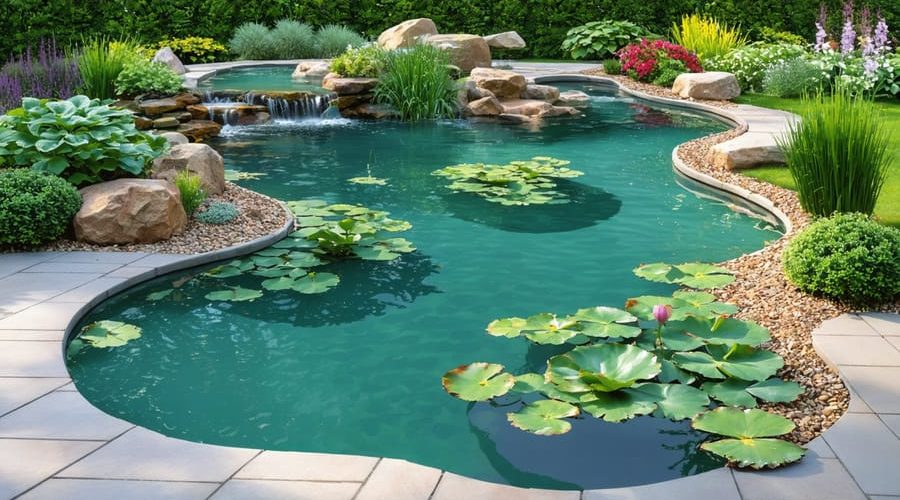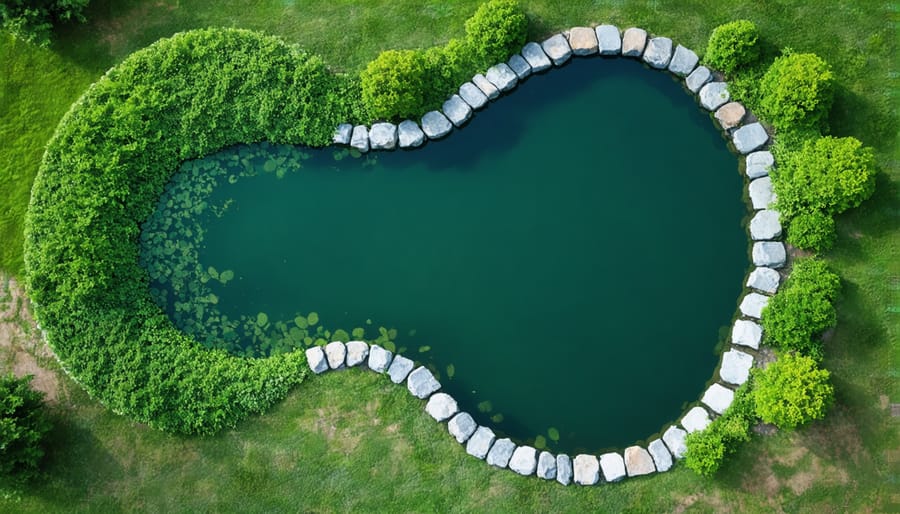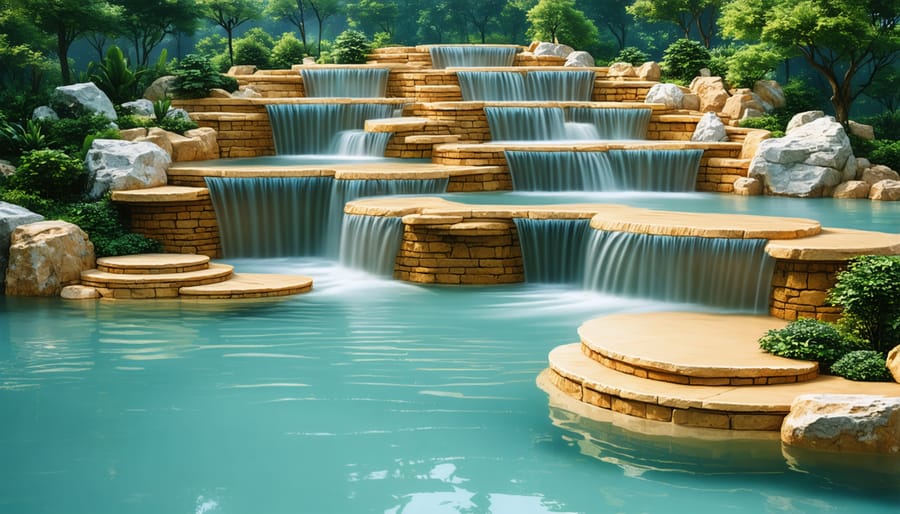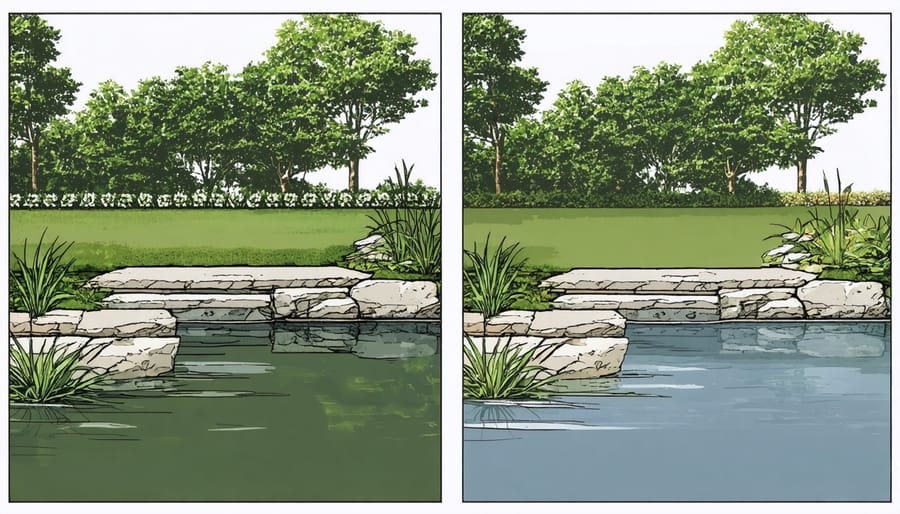
Transform Your Backyard Pond into a Natural Paradise: Organic Shapes That Captivate
Nature’s most beautiful ponds never follow straight lines or perfect circles. Instead, they curve and meander like ancient riverbeds, creating organic shapes that blend seamlessly with the surrounding landscape. These free-flowing forms mirror what we see in natural lakes and wetlands, where water has carved its own path through soil and stone over countless seasons.
When designing a natural pond, imagine how water would naturally collect in your landscape. Study the gentle S-curves of streams, the rounded bays of lakeshores, and the irregular edges where land meets water. These organic shapes not only look more authentic but also create diverse micro-habitats for wildlife and plants along varied depths and edges.
The most successful natural pond designs incorporate multiple curves of different sizes, with some areas featuring shallow, gradual slopes for wetland plants, while others drop off more dramatically for deeper water species. This variation in shape creates visual interest and ecological diversity, making your pond feel like it’s always been part of the landscape rather than a recent addition.
Whether you’re planning a small garden pond or a larger water feature, remember that asymmetry and gentle curves are your allies in crafting a water feature that looks as though it was shaped by nature itself.
Why Natural Pond Shapes Matter
Mimicking Nature’s Blueprint
In nature, ponds aren’t created with straight lines or perfect circles – they’re shaped by the natural flow of water, erosion, and the surrounding landscape. Natural ponds typically feature irregular curves, varying depths, and gentle slopes that blend seamlessly with their environment. These organic shapes aren’t just aesthetically pleasing; they’re functional designs perfected by millions of years of natural processes.
When creating your own pond, observing these natural patterns can guide you toward more authentic results. Look for inspiration in how stream banks curve, how shorelines weave, and how water naturally pools in depressions. Incorporate gradual transitions between different areas, avoiding harsh angles or sudden drops. Consider how rainfall would naturally collect in your landscape and use these natural low points as inspiration for your pond’s placement and shape.
The most convincing artificial ponds often mimic the way water naturally interacts with the landscape. This might mean creating shallow marshy areas, incorporating weathered rocks of varying sizes, or adding subtle peninsulas and bays along the edges. Remember, nature rarely works in perfect symmetry – embracing some irregularity in your design will result in a more authentic-looking water feature.
The Psychology of Organic Design
Natural shapes in pond design do more than just look pretty – they have a profound effect on our psychological well-being. When we encounter curved, flowing lines and organic shapes in nature, our brains respond differently than when faced with rigid, geometric patterns. These natural forms, which include the essential sculptural elements of your pond, help create a sense of calm and reduce stress levels.
Think about how you feel when walking through a meandering garden path versus a straight concrete walkway. The same principle applies to pond design. Curved edges and natural contours guide the eye gently around the water feature, creating a more immersive and relaxing experience. These organic shapes mirror what we see in nature, making the pond feel like it’s always been part of the landscape.
Studies have shown that spending time near water features with natural shapes can lower blood pressure and anxiety levels. The combination of flowing water sounds and organic design elements speaks to something primitive in our brains, helping us feel more connected to nature and promoting a sense of peace in our outdoor spaces.
Popular Natural Pond Shapes
Kidney-Shaped Designs
Kidney-shaped ponds are among the most popular natural designs, and for good reason. Their curved, organic form mimics the gentle bends found in natural water bodies, creating a harmonious flow in your landscape. The distinctive curved indentation along one side adds visual interest and creates perfect spots for viewing areas or specialized planting zones.
This shape works particularly well in medium to large gardens, as it provides multiple vantage points and creates natural divisions in your outdoor space. The concave area is ideal for positioning a seating area or deck, allowing you to get closer to the water and enjoy different perspectives of your pond life.
When implementing a kidney design, consider orienting the curved indent toward your main viewing area, such as your patio or house windows. This arrangement maximizes visual impact and creates a natural focal point. The wider ends of the kidney shape provide excellent opportunities for deeper planting zones and fish habitats, while the narrower middle section is perfect for shallow marginal plants.
For the most natural look, vary the depth along the pond’s outline and soften the edges with carefully placed rocks and overhanging plants.

Figure-Eight Formations
Figure-eight ponds offer a perfect blend of natural flow and artistic design, creating an engaging visual that draws the eye through your garden landscape. This flowing shape mimics natural waterways while providing distinct zones for different aquatic features. To create this design, start by marking out two connecting circles of equal size on your planned site, allowing them to overlap slightly in the middle.
The beauty of figure-eight formations lies in their versatility. The narrowed center creates a natural bridge point, perfect for positioning a decorative crossing or viewing area. Each loop can serve different purposes – perhaps one for deeper water plants and fish, while the other maintains a shallow depth for marginal plants and wildlife.
When excavating, ensure smooth transitions between the loops and vary the depth gradually. The curved edges provide excellent opportunities for strategic rock placement and waterfall features. For the most natural look, avoid making the circles too perfectly round – slight irregularities will enhance the organic feel of your pond.
Remember to include gentle slopes around the edges, creating safe entry and exit points for wildlife and easy maintenance access. This design works particularly well in medium to large gardens where the full shape can be appreciated from multiple viewing angles.
Free-Form Curves
When creating a natural pond, the key to achieving an authentic look lies in avoiding rigid geometric shapes and embracing free-flowing curves. Nature rarely creates perfect circles or straight lines, so let your design flow organically with the landscape. Start by laying out a garden hose or rope to experiment with different curved shapes, stepping back occasionally to view the outline from various angles.
Consider the natural contours of your yard and how water would naturally pool in the space. Incorporate gentle bends and irregular curves that mirror the surrounding landscape features. These organic shapes not only look more natural but also create interesting nooks for smart planting techniques and aquatic life.
Remember to vary the depth and width of your curves – some areas can be broader while others taper naturally. This variation adds visual interest and creates different zones for plants and fish. Think of how a stream meanders through the countryside, with its edges softened by vegetation and natural erosion. Your pond’s curves should tell a similar story, appearing as though they’ve always been part of the landscape rather than recently constructed.
Multi-Level Designs
Adding multiple levels to your pond creates a more dynamic and natural-looking water feature that mirrors what you’d find in nature. Just like a mountain stream cascades down different levels, your pond can incorporate varying depths that create visual interest and support different types of aquatic life.
Start with a shallow shelf around the edge, about 6-12 inches deep, perfect for marginal plants and providing safe access for wildlife. Moving inward, create a middle shelf at 18-24 inches deep for water lilies and other deep-water plants. Finally, include a deep zone of at least 30 inches to give fish a safe place to overwinter and escape predators.
These different levels also create opportunities for beautiful cascades and waterfalls between zones. Consider adding natural stone ledges or carefully placed boulders to create gentle transitions between levels. The varying depths create shadows and light play on the water’s surface, adding another dimension of visual interest to your pond.
Remember to slope the sides gradually between levels, avoiding sharp drops that could be dangerous or look artificial. This multi-level approach not only enhances the pond’s natural appearance but also creates distinct ecological zones for a thriving aquatic ecosystem.

Design Tips for Natural Shapes
Working with Your Landscape
Creating a natural pond that harmonizes with your existing landscape starts with careful observation of your garden’s natural flow and features. Look for natural dips or slopes in your yard that could guide the pond’s placement and shape. If you have existing rock formations or mature trees, consider incorporating these elements into your pond design, allowing them to influence the curves and contours.
Work with your garden’s topography rather than against it. A pond nestled into a natural depression will look more authentic than one forced into a flat area. Consider how water would naturally pool in your landscape and use these patterns to inform your design. This approach not only creates a more organic look but can also help with practical matters like drainage.
Existing pathways and garden features can serve as natural boundaries or focal points for your pond. For example, a curved garden path could inspire a complementary curve in your pond’s edge. Strategic placement of aquatic plants and dynamic lighting effects can help blend the pond seamlessly with surrounding plantings.
Remember to consider viewing angles from key areas like patios, windows, or seating areas. The shape should look natural and inviting from these vantage points. By following the natural contours and features of your landscape, your pond will appear as though it’s always been part of your garden.
Edge Treatment Techniques
Creating natural-looking pond edges is essential for achieving that seamless, organic appearance in your water feature. The key is to blend the transition between water and land using various techniques that mimic natural textures and materials.
One popular method is the graduated slope technique, where you create different levels of depth around the pond’s edge. Start with shallow shelves near the border and gradually increase the depth toward the center. This not only looks more natural but also provides different zones for various aquatic plants.
Rock placement plays a crucial role in edge treatment. Arrange rocks of varying sizes along the pond’s perimeter, partially submerging some while leaving others visible above the waterline. Overlap them slightly to create a more organic look, and tuck smaller stones between larger ones to fill gaps naturally.
Consider incorporating beach areas using smooth gravel or sand that slopes gently into the water. These areas not only look fantastic but also provide easy access for wildlife and maintenance. For a softer edge appearance, plant marginal vegetation along the borders, allowing it to spill slightly over the water’s edge.
Don’t forget to hide your pond liner by folding it up behind rocks or covering it with soil and plants. This attention to detail ensures your pond edges look as natural as possible, creating that perfect illusion of a pond that’s always been part of your landscape.

Common Design Mistakes
When designing natural ponds, several common mistakes can detract from the authentic feel you’re trying to achieve. One frequent error is creating perfectly symmetrical shapes – nature rarely works in perfect circles or straight lines. Instead, aim for irregular curves and organic flowing forms that mimic natural water bodies.
Another mistake is making the pond too small for its surroundings. A tiny pond in a large backyard can look out of place and artificial. Consider the scale of your landscape and ensure your pond’s size complements the available space.
Many DIY enthusiasts fall into the trap of creating uniform depth throughout the pond. Natural bodies of water have varying depths, with gradual transitions from shallow margins to deeper areas. This variation not only looks more natural but also creates diverse habitats for plants and wildlife.
Overlooking the viewing angles is another pitfall. Consider where people will most often see the pond – from the house, patio, or garden paths. Design your pond’s shape to look appealing from these key viewpoints.
Edge treatment is crucial – avoid leaving liner visible or creating sharp, artificial-looking margins. Some pond builders make the mistake of having uniform plant spacing around the edges. In nature, plants grow in random clusters with varying densities, so try to replicate this pattern.
Lastly, don’t forget about the surrounding landscape. A common error is failing to integrate the pond with existing features, making it look like an afterthought rather than a natural part of your garden.
As we’ve explored throughout this article, incorporating natural pond shapes into your water garden design can transform an ordinary backyard into a breathtaking oasis. By following nature’s blueprint and embracing organic curves, irregular edges, and varying depths, you can create a water feature that looks like it’s always been part of your landscape.
Remember that successful natural pond design relies on careful observation of how water bodies occur in nature. Whether you’re drawn to the gentle meandering of streams, the perfect circles of spring-fed pools, or the complex shorelines of natural lakes, there’s endless inspiration to draw from the natural world.
The key principles we’ve discussed – working with your landscape’s natural contours, incorporating multiple curves and bays, varying the depth profile, and adding natural transitions – will help you achieve that sought-after organic look. Don’t forget that seemingly random elements like jutting rocks, fallen logs, and varying plant heights all contribute to the authentic feel of your pond.
While planning and creating a naturally-shaped pond requires more thought than simply digging a rectangular hole, the rewards are well worth the effort. A naturalistic pond not only provides a more attractive focal point for your garden but also creates better habitats for wildlife and requires less obvious maintenance to keep it looking its best.
As you begin your pond project, take time to sketch different designs, experiment with shapes using a garden hose, and carefully consider how your pond will interact with its surroundings. Remember that there’s no single “right” way to create a natural-looking pond – each design should be as unique as the landscape it inhabits.
We encourage you to embrace these natural design principles in your own pond project. Whether you’re starting from scratch or renovating an existing water feature, implementing these ideas will help you create a more harmonious and visually appealing water garden that you’ll enjoy for years to come.
